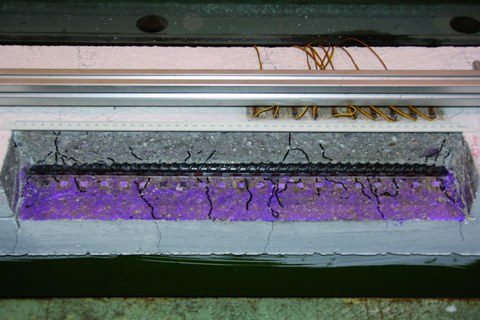Collaboration fib TG-4.1 "Serviceability Models" and participation CEOS-Workshop "Control of Cracking in R. C. Structures: a Major Step Towards Serviceability"
Table of contents
Project data
| Titel | Title Mitarbeit in fib TG-4.1 „Serviceability Models“ und Teilnahme am CEOS-Workshop „Control of Cracking in R.C. Structures : a Major Step Towards Serviceability“ | Collaboration fib TG-4.1 "Serviceability Models" and participation CEOS-Workshop "Control of Cracking in R. C. Structures: a Major Step Towards Serviceability" Förderer | Funding Institut für Massivbau, TU Dresden Zeitraum | Period 2009 Leiter & Bearbeiter | Project Manager & Contributor Dr.-Ing. Lars Eckfeldt |
Report in the yearbook 2009
Exploratory Research on Cracks

Internal micro-cracking in the bond zone of RC
The overall goal for a variety of work performed under fib task group 4.1 is to improve the robustness of estimates for representative crack widths. This approach employs existing datasets to allow for in-depth research into model quality. These datasets incorporate parameters that have been identified to date and are suitable for model calibration. This project focuses attention on the explorative and statistical data analysis of the effect of various parameters; the examination of fundamental model assumptions; and the interrelationship between bond stress distribution and surrounding crack pattern.
Current European, American and Russian models for characteristic crack widths, as well as model proposals were studied. This undertaking incorporated the task of developing tailored methods for data analysis, sampling strategies, and the use of advanced testing of correlation and interrelationships accordingly. Measurements taken from long bond lengths provided information concerning the development of bond stresses and microcracking. Simulations helped to disclose reasons for the randomness of mean crack spacing and representative crack widths.
Future Intentions
The CEOS-Workshop, held in Paris in 2009, served as a platform for discussing recent findings within the research field of cracking, particularly in the area of primary influential factors and related design. Initial results from stochastic simulations were presented. These took into account random strength fields and successive crack development. Findings indicate that the distribution of crack widths under constant conditions is lognormal over wide areas. As expected by the application of the central limit theorem, mean crack widths are normally distributed. Maximum crack widths tend once again to form a lognormal distribution, while the extremes tend toward the formation of a Gumbel distribution.
The particular difficulties of accurate crack problem assessment have been noted relative to the potential of limit state research and reliability analysis. Design analysis supporting a particular design criterion can only reproduce the original percentile selected, which still, however, leads to a far too high failure probability when compared to the requirements of Eurocode 0. Coupling this problem with probabilistic durability boundary conditions may produce more realistic figures that better correspond to experience.
Reference
Eckfeldt, L.: Random Effects Inside the Cracking Data of RC Tests. Proceedings of the 6th International Probabilistic Workshop, Darmstadt, 2008, p. 183-205
